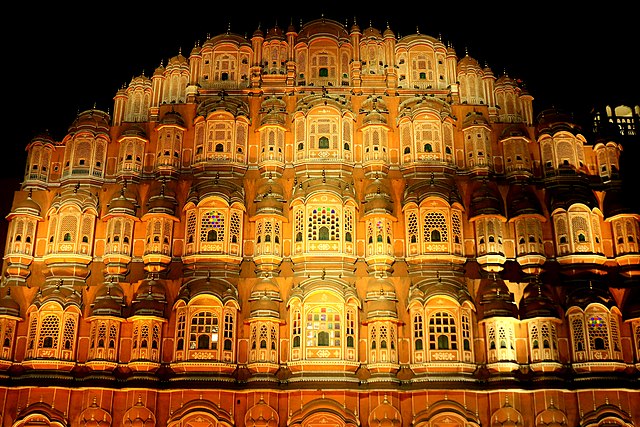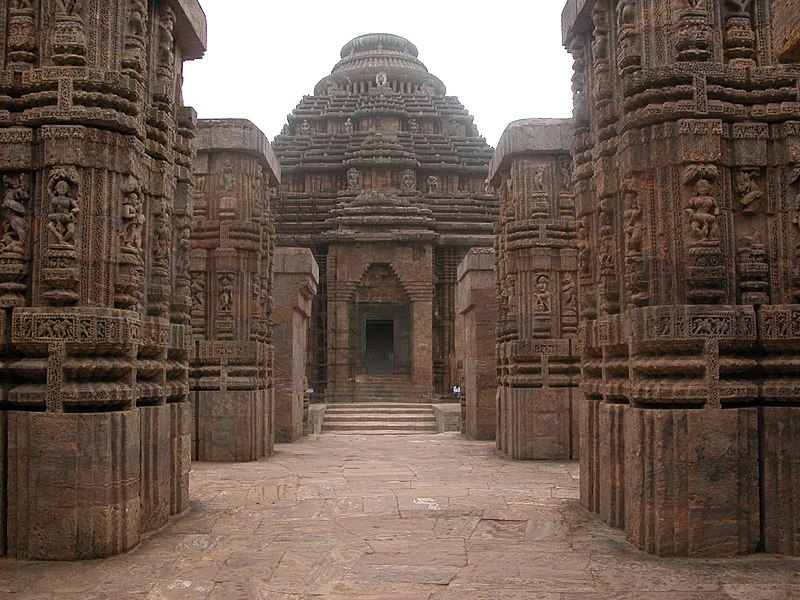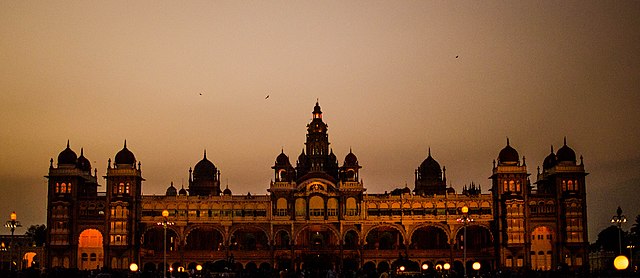India is world famous for it’s many great temples and shrines, yet it also boasts many great buildings of historical note.
Massive palaces, monuments and Victorian era buildings are spread across the major cities
Here are some of the most famous buildings in India.
Famous Buildings in India
1. Taj Mahal

Located in the Indian city of Agra on the right bank of the river Yamuna, the Taj Mahal is an Islamic mausoleum made of ivory-white marble.
The tomb of Shah Jahan and his favorite wife Mumtaz Mahal was built here in 1632 at the request of the Mughal emperor, who ruled from 1628 until he died in 1658.
The tomb is located amid formal gardens that are surrounded on three sides by a crenelated wall and is the centerpiece of a 42-acre complex that also features a mosque and a guest house.
Also Read: Landmarks in India
The main part of the mausoleum was finished in 1643, but for the next decade, workers focused on finishing the structure.
The Taj Mahal makes use of a wide range of symbolism to convey its themes of divine love and natural splendor. In 1983, the Taj Mahal was included on the list of World Heritage Sites maintained by UNESCO.
2. Hawa Mahal

One of the most famous buildings in Jaipur, India, is the Hawa Mahal. It is an outbuilding made of red and pink sandstone that connects to the Zenana (women’s rooms) of Jaipur’s City Palace.
This palace was constructed in the year 1799 by Maharaja Sawai Pratap Singh.
He constructed this magnificent and ancient palace after being moved by the Khetri Mahal’s one-of-a-kind design. Lal Chand Ustad was responsible for its creation. With its 953 tiny windows, or Jharokhas, and ornate latticework, the building’s facade looks like a honeycomb.
The latticework was originally built to shield royal women from prying eyes while they observed daily life and festivals on the street below.
Some of the attractions of this landmark include the stone-carved screens, small casements, and arched roofs. It also contains hanging cornices that are artistically designed.
3. Konark Sun Temple

Located on the coast of Odisha, India, 35 km northeast of Puri city, the Konark Sun Temple dates back to the 13th century CE (1250).
The Eastern Ganga regime’s king Narasimhadeva I is acknowledged for constructing the temple in 1250 CE.
Originally built as a shrine to the Hindu sun god Surya, the ruins of this temple seem like an enormous chariot pulled by massive stone wheels and horses.
Also Read: Famous Temples
The buildings and features that have been preserved are renowned for their elaborate artwork, iconography, and motifs, some of which are sensual, such as depictions of kama and mithuna.
It is a prime example of the Kalinga or Odisha architectural style and is also known as the Surya Devalaya. A prominent Hindu pilgrimage site, in 1984, it was designated a UNESCO World Heritage Site.
Because of its significance to Indian history and culture, the Temple is featured on the back of the 10 rupee note.
4. Mysore Palace

The Mysore Palace or Amba Vilas Palace is steeped in history and used as a royal residence.
In the past, this building served as the capital of the Kingdom of Mysore and the official palace of the Wadiyar family. It boasts a commanding eastern view of the Chamundi Hills.
The Mysore Palace in the new fort is the one that is being referred to here. Mysuru was the ancient name for the site on which the palace presently stands.
In the 14th century, Yaduraya constructed the first palace inside the Old Fort, and despite being burned down and rebuilt several times, it still stands today.
The current fort is made of wood, stone, and bricks, while the old one was made entirely of wood and so was easily burned down.
Following the destruction of the Old Palace in a fire in 1897, construction of the current building began; it was completed in 1912.
5. Lotus Temple

Dedicated in December 1986, the Lotus Temple is a Bahá’s House of Worship in Delhi, India. It has become a city landmark due to its flower-like design.
The Lotus Temple, along with all other Bahá’s places of worship, welcomes people of all faiths and walks of life.
The structure’s 1,300-person capacity is housed in a central hall with a ceiling height of just over 34 meters and 27 freestanding, marble-clad “petals” grouped in nine-side clusters.
Many publications have written about the Lotus Temple because of its unique architecture and its many accolades.
The Lotus Temple, like all Bahá’ Houses of Worship, is required to adhere to particular architectural standards. The son of the faith’s founder, Abdu’l-Bahá, specified that a House of Worship must have a circular plan with nine equal sides.
6. Golden Temple

Amritsar, Punjab, India is home to the gurdwara known as the Golden Temple. To Sikhs, it is the holiest of holy places.
Along with Gurdwara Janam Asthan in Nankana Sahib and Gurdwara Darbar Sahib Kartarpur in Kartarpur, it is one of Sikhism’s three most sacred places.
In 1577, Guru Ram Das, the 4th Sikh guru, finished building a pool in front of the shrine. Guru Arjan installed the Adi Granth in Harmandir Sahib in 1604. The Gurdwara was a subject of oppression for the Mughals and invading Afghan forces, yet the Sikhs repaired it repeatedly.
After establishing the Sikh Empire, Maharaja Ranjit Singh had it reconstructed in 1809 using marble and copper, and then in 1830, he covered the sanctuary in gold leaf.
Because of this, it’s been known as “the Golden Temple.” After being severely damaged in 1984, the Gurdwara building was reconstructed.
7. Charminar

Hyderabad, Telangana, India is home to several historical landmarks, including the 1591-built Charminar Mosque.
The building is now recognized all over the world as a representation of Hyderabad, and it is included in a list of the most recognizable buildings in India.
Additionally, it is now the official Telangana state emblem. In its long history, the Charminar has had a mosque on its upper floor for over 425 years.
In addition to its historical and spiritual significance, the area around the building is famous for its bustling and prosperous local markets.
It’s now among the city of Hyderabad’s most popular tourist destinations. Due to its proximity to the city’s primary mosque, Makkah Masjid, many religious festivals, including Eid-ul-Adha and Eid al-Fitr, are celebrated there.
8. Victoria Memorial

The Victoria Memorial, located in Central Kolkata’s Maidan and constructed from 1906 to 1921, is a massive marble structure.
To the memory of Victoria, Empress of India between 1876 and 1901. Set on 64 acres of grounds, this museum under the care of the Ministry of Culture is the greatest monument to a monarch anywhere in the world.
There are 25 exhibit spaces at the Victoria Memorial. There is the central hall, the gallery of sculpture, the gallery of arms and armor, the gallery of arms and armor, the gallery of arms, and the modern gallery in Kolkata.
Thomas Daniell’s works between 1749 and 1840, as well as those of his nephew William Daniell between 1769 and 1837, are housed in the Victoria Memorial in the greatest single collection of their kind.
Nawab Wajid Ali Shah’s publications on kathak dance plus thumri music, as well as the illustrated works of Shakespeare and the Arabian Nights, are among the rare and ancient books here.
But the merely architectural gaps or voids are not outdone by the museums and their displays, the memorial’s programmatic elements.
9. Brihadisvara Temple

The Brihadishvara Temple, also known as the Thanjai Periya Kovil and the Rajarajeswaram, is a Shiva temple in the Hindu Dravidian style that you can see on the Cauvery River’s south bank in Tamil Nadu.
The shrine is topped by a granite vimana tower, making it among the tallest in south India. The temple is home to one of India’s biggest Shiva lingas as well as a gigantic, columned prakara (corridor).
It also gained notoriety in the 11th century when the bronze Nataraja, depicting Shiva as the lord of dance, was created there.
It is a magnificent example of a Hindu temple and Tamil architecture at its finest. Dakshina Meru is the name of this mountain. The temple was commissioned by the Chola emperor Rajaraja I and constructed between 1003 and 1010 CE.
It is one of three temples from the Chola period that make up the UNESCO World Heritage Site recognized as the “Great Living Chola Temples.”
10. Gateway Of India

In the 1920s and 1930s, the city of Bombay (presently Mumbai) India constructed an arch-monument known as the Gateway of India.
It stands on Ramchandani Road, not far from Shyamaprasad Mukherjee Chowk, as a tribute to King-Emperor George V, the very first British royal to enter India in December 1911.
In March of 1913, the first stone was placed for a monument that would be constructed in the Indo-Islamic style, drawing inspiration from Gujarati architecture from the 16th century.
The architect George Wittet’s final design for the monument wasn’t approved until 1914, and the building didn’t wrap up until 1924. The basalt memorial arch stands at a towering 26 meters (85 feet) tall and was designed to evoke both classical and traditional Gujarati styles.
Once the Gateway was built, it served as a symbolic gateway for high-ranking colonial officials into India.
After India gained its independence from the United Kingdom in 1948, the last remaining British forces marched out of the country through the Gateway.

